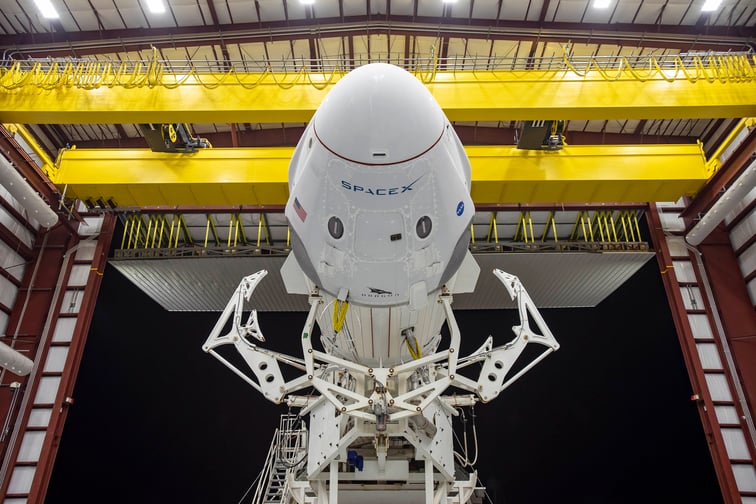

It's been a historic year for the global space industry. On May 30, millions of people around the world tuned in to watch the launch of SpaceX’s Crew Dragon capsule to the International Space Station. This monumental event marked not only the first time that NASA astronauts have taken off from US soil since 2011, but also the first time that a commercially designed and built spacecraft carried astronauts into space. Now, after the astronauts’ safe return to Earth on 2 August, hopes are high for the future of commercial space travel.
“A new era for space commercialisation is unfolding right now,” says Peter Elson, CEO of Gallagher’s aerospace practice. “Some events in the wider space industry may have a déjà vu quality, such as the [use of the] Falcon 9 rocket. But what was new in those operations was the central role played by a commercial company. In the past, missions of this scale and complexity were the sole preserve of government agencies.”
Until 2012, space insurance premium was typically in the range of US$750m to US$1bn a year, says Chris Kunstadter, global head of space at AXA XL. From 2012 to 2019, that number steadily dropped; 2019 was an illuminating year for the global space insurance sector. Total written premium was approximately US$500m, while total losses amounted to around US$800m, which is well within the typical range of losses over the past 20 years. However, combined with the lower premium, this caused concerns for some space insurers over the volatility of the line of business. Some pulled out of the sector altogether, while others cut capacity or put in restrictions to minimise their exposures.
“For the brave investor, rewards can be exceptional – and insurance is critical to underpin the financial risk that goes hand in hand with those potential rewards” Peter Elson, Gallagher
“It will be interesting to see how the rest of this year goes,” Kunstadter says. “July, for instance, turned out to be a huge month for insured launches – and uninsured launches, too. Up through the first half of this year, the global insurance premium for space insurance amounted to about $120m, and we’re expecting the same amount of premium just from launches in July alone.”
With so much renewed attention on the opportunity for space commercialisation, it’s likely that the insurance industry’s role in driving the next step will also be subject to increased scrutiny. Insurance is, and will continue to be, a key enabler of space commercialisation, Elson says, explaining that space projects require significant investment, much of which is incurred way ahead of any revenue coming on stream.
“For the brave investor, rewards can be exceptional – and insurance is critical to underpin the financial risk that goes hand in hand with those potential rewards,” he says. “In the long run, insurers and brokers will need to get to grips with some fundamental shifts in demand.”
In time, Elson says, the pace at which technology can be developed and implemented is likely to expand commercial opportunities in both the space industry itself and for the insurers supporting those ventures. Today, the commercial space industry is in the development stage, which poses some real challenges to insurers in terms of the products and services they provide for unproven technology, as well as the resource-heavy technical process they follow in evaluating risks.
Kunstadter stresses that insurance companies’ involvement must go beyond simply insuring risks – AXA XL is involved in a broad range of space industry activities, from business development to outreach and advocacy. Kunstadter says insurers must be at the very forefront of understanding to address the risks that others have not yet figured out how to deal with.
“We want to make sure we have smart clients, smart brokers and even smart competitors. If we have these, then people aren’t going to be doing silly things” Chris Kunstadter, AXA XL
“We’re working with the industry to try and develop standards [and best practices],” he says. “And we have a lot of statistics that we share within the industry because we want to make sure we have smart clients, smart brokers and even smart competitors. If we have these, then people aren’t going to be doing silly things, and [this prevention] will help the industry overall.”
The coming years should present new opportunities within the insured launch sphere, Kunstadter says, citing the development of space systems by Virgin’s Richard Branson and Amazon’s Jeff Bezos, who will likely be looking for insurance solutions to protect their investments.
Meanwhile, Elson notes that SpaceX is part of a very successful cadre of commercial businesses with the vision and backing to open up a raft of new opportunities in space. From Branson’s Virgin Galactic and Bezos’ Blue Origin to the space communication arena, where Amazon’s Project Kuiper and SpaceX’s Starlink are looking to provide accessible global broadband services using constellations of loworbiting spacecraft, the future of space commercialisation is clearly already underway.
